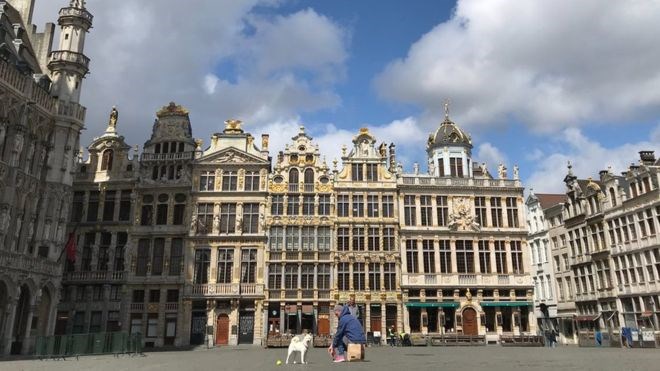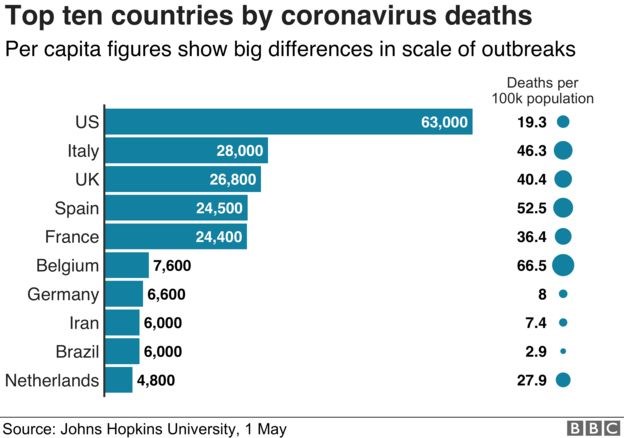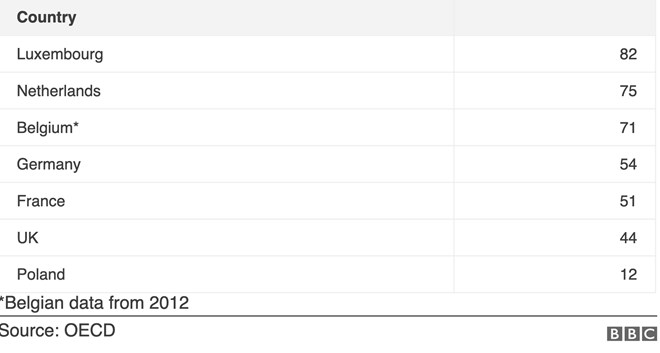
Saturday May 2, 2020

One man and his dog are the only visitors in a normally busy Grand Place in central Brussels
Belgium is the world's worst affected country when it comes to the coronavirus mortality rate.
That rate, unlike the total number of fatalities, is a measure of the number of deaths in relation to the size of population.
President Donald Trump pointed to a graph recently, displaying Belgium at the top and the US in seventh place, as a result of the number of deaths relative to population size.
He was suggesting the US was handling the pandemic more effectively.
Belgium has a population of 11.5 million. That means 66 people in every 100,000 have died from Covid-19. In the US, with a population of around 330 million, it's 19 in every 100,000, according to Johns Hopkins University data.
But those figures are "faulty comparisons" that have been "abused", argues Prof Steven Van Gucht, a Belgian virologist and government spokesman."That's the difference between public health science and political motivation," he explains. "That's purely inspired by showing how good you are doing, and it's wrong. We are actually reporting in a more correct way."
What's different about Belgium?
Belgian officials say they are counting in a way that no other country in the world is currently doing: counting deaths in hospitals and care homes, but including deaths in care homes that are suspected, not confirmed, as Covid-19 cases.
According to Belgium's latest official figures, out of 7,703 deaths, 53% have been in care homes.

Some 16% of deaths in care homes were tested positive for coronavirus. The rest are suspected.
That means more than 3,500 deaths have been counted as caused by Covid-19, but not confirmed.
How do they work it out?
"It's based on the assessment of the medical doctor, usually taking into account whether the coronavirus is present in the same care home," says Prof Van Gucht.
"For example: if you have one or two confirmed cases, then the week after you have 10 deaths in the same home based on similar symptoms."

Prime Minister Sophie Wilmès recently suggested Belgium may be over-reporting the actual number of cases.
However, Prof Van Gucht says the real number of deaths may still be higher than they are reporting, as he believes they may still be missing a few cases.
Is it just down to counting?
Another factor is that many more people here put loved ones in care homes than elsewhere in Europe.
Only the Netherlands and Luxembourg have a higher rate of care home occupancy, relative to their populations.
Long-term care in Europe
Over-65s in care per 1,000 people

Officials also acknowledge mistakes were made at the beginning: poor preparation left care home staff lacking personal protective equipment (PPE). That allowed the virus to spread quickly, with devastating effect.
Now all nursing home staff are issued with masks and protective clothing, and nurses from hospitals and the military have been brought in to help.
Epidemiologists say they've found a "remarkable" observation in care homes, that around 10% of residents have been asymptomatic carriers of the virus and have built up an immunity. A small comfort, but of important scientific value.
How long has Belgium been in lockdown?
Since 18 March all non-essential business has been closed and, apart from emergency workers, people have been asked to stay at home.
Shopping is limited to one person per family. You can leave the house for medical reasons, to walk the dog, or for an hour's exercise with immediate family, or one other person, while maintaining social distancing of at least 1.5m (5ft).
Belgian police have been enforcing the lockdown, using drones in parks and fines for anyone breaking social distancing rules.
Checkpoints have been set up at the borders with Luxembourg, France and the Netherlands, allowing through only cross-border workers, or those with an urgent reason to enter Belgium.
Some cyclists have been fined after taking a ride into the Netherlands, then being stopped by Belgian police on the way back.
Neighbours with different lockdowns
All non-food shops have been closed too, which led to a bizarre incident in the neighbouring towns of Baarle Hertog and Baarle Nassau, where the border line runs through a bargain store called Zeemans.
The Dutch half of the shop is open, but the Belgian half has been taped off, with customers unable to get to the men's clothing section.
Unlike Belgium's policy, the Netherlands has what Prime Minister Mark Rutte described as an "intelligent lockdown", with florists, ironmongers, bakeries, clothes and toy stores remaining open.
There have been fewer deaths in the Netherlands, despite having a larger population. But unlike Belgium, the Netherlands does not count suspected Covid-19 deaths in care homes.
I asked the head of Belgium's Covid-19 taskforce, Minister Philippe De Backer, if he thought the Belgian confinement method was more effective than the more relaxed Dutch and Swedish approaches.
He told me Swedes were renowned for following government advice, while it was "a bit more difficult in a country like Belgium". However, he was generally "impressed by how Belgians has dealt with the crisis".What happens next?
Belgium will lift its lockdown gradually, in four phases. From Monday, fabric stores are being opened so people can buy material to make their own face masks. Masks will be mandatory on public transport.
Sport will be allowed, too, though no more than two people can play together.
All other shops will open from Monday 11 May. Schools will restart on 18 May, with a maximum of 10 students per class.
Cafes, restaurants and some tourist attractions will open after 8 June, if there has been no second spike in cases. Trips abroad may also be allowed in early June.